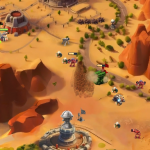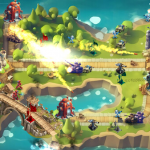Z:Steel Soldiers
Since the original game Z became so popular, the Bitmap Brothers decided to work on a sequel. In 2001 the Bitmap Brothers released “Z:Steel Soldiers”, serving the same real-time strategy idea, but graphically completely redone, now being a true Windows 32Bit application. With the new 3D graphic engine came a completely new way of controlling the game also requiring the hardware to run it smoothly.
Z:Steel Soldiers never made it as big as its predecessor. Too new was the interface, too different was the “feel” of it. It was simply too good and too advanced in comparison to Z and that was not what the fans wanted. They wanted the same Z, just better in true 32bit and a higher resolution.
However, quite a lot of fans love it. Z:Steel Soldiers introduced flying equipment like helicopters and bunch of other new aspects to the battles. The terrain is now 3D and can be viewed from different angles.
I give this game 3.5 of 5 stars!
What the Bitmap Brothers say about the game
- Z: Steel Soldiers takes the core structure of the original title and immerses the player into an experience that is altogether more refined.
- Z: Steel Soldiers’ focus like Z is as an arcade-strategy title where the emphasis is on the players’ real-time combat decisions and their subsequent consequences.
- Z: Steel Soldiers has evolved from the benchmark that Z created by retaining the elements that made Z a great game and plunging them into realistic 3D environment. As a direct consequence of this, Z: Steel Soldiers has become truly representative of a ‘real world’ war zone in that every metre of ground needs to be fought for as a result of the territory based nature of the game play.
- Each world type that battle takes place upon has been carefully crafted with its own unique environment, whether it be sun bleached dessert or dark forest each with its own environmental system and localised life forms.
- The war machine that the player commands has been completely reworked and extended within Z: Steel Soldiers compared to the original. Again due to the fact that highly realistic terrain environments exist within the game, it seemed only fair to give the player a full naval and air force to command as well as the robotic infantry and armoured fighting vehicles from the first game. In total there are 30 unit types and 20 building types for the player to experiment with. In addition to the original array of Robots, there is a new core of elite infantry units that have been introduced; the Technician, Explosives Expert and the Spy.
- You can still snipe enemy vehicles, even aircraft when they are on the ground and then commandeer them for your own ends. Viruses can be planted within enemy installations disrupting manufacturing processes, buildings can be stolen and a variety of heavy weaponry is on offer.
- Z: Steel Soldiers allows you to build your own base where you want to rather than having predefined building positions. The only constraint on the player is that you have to own the land that you wish to build upon, so you are still forced to go out and conquer the terrain in the region. When you take possession of a territory a mine is built that harvests Xenonite that is converted into currency for the player to fund the expansion of their forces.
- Unlike the original, Z: Steel Soldiers is plot driven with the player progressing through a campaign that takes place over 6 vastly different worlds, 30 levels in total. The mission structure of the game takes this into consideration with the player having to achieve a plethora of objectives in their battle against the blue forces. As with the original the robotic infantry units all have their own individual personalities and act accordingly. From the script there are a number of “Hero” characters that also play an important part in the game and will often help or in some cases hinder the player in their quest, depending on who’s side they are on. All of these characters obviously have their own visual identity with slim, dexterous Snipers running for the high ground and large, hulking Tough robots with their massive shoulder mounted missile launchers ambling into battle.
- The multiplayer aspect of the game gives the player the chance to enter into a Skirmish game with up to seven simulated opponents or a choice of human and simulated adversaries. The game can be played online or on a LAN with up to a maximum of 8 players. There are many types of multiplayer game on offer including timed, resource based, unit based and objective based game play environments.
Details
| Developer | The Bitmap Brothers |
| Publisher | EON Digital Entertainment, SCi |
| Copyright | © 2001 The Bitmap Brothers |
| Distributor | Sold Out, Red Ant Entertainment, PAN Vision |
| Release Date | North America: 2001-06-15 Australia/Asia: 2001-08-08 |




